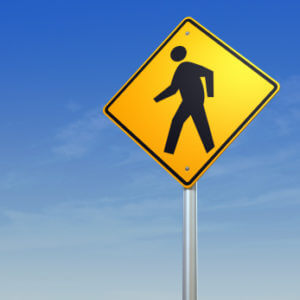 When operating a vehicle or acting as a pedestrian, “right of way” means that one person or vehicle should be allowed to move before any others. When it comes to pedestrians, who often share parts of the road with motor vehicles, it is important to understand when the pedestrian should yield to the vehicle, and when he or she has the right of way over a car. In any situation, no matter who has right of way, an operator of a vehicle must take every reasonable precaution to ensure the safety of a pedestrian, especially children or those who are in some way impaired.
When operating a vehicle or acting as a pedestrian, “right of way” means that one person or vehicle should be allowed to move before any others. When it comes to pedestrians, who often share parts of the road with motor vehicles, it is important to understand when the pedestrian should yield to the vehicle, and when he or she has the right of way over a car. In any situation, no matter who has right of way, an operator of a vehicle must take every reasonable precaution to ensure the safety of a pedestrian, especially children or those who are in some way impaired.
Between intersections, along general roadways, vehicles typically have the right of way over pedestrians or bicyclists. This means that anyone crossing a street or walking in the street must be aware of motor vehicles and yield to them, in order to ensure the safety of the pedestrian and the driver, as well as the safety of others around them.
In Illinois, pedestrians have the right of way at crosswalks in a number of different situations. Crosswalks are generally defined as a part of the road specifically indicated for pedestrian crossing, usually via a pair of lines and marked by a sign, or an area of an intersection allowing crossing from one sidewalk to another for a pedestrian. With that in mind, drivers must yield to a pedestrian when…
- Traffic signals are not in place or operational;
- The pedestrian is on the same side of the street as the driver;
- The pedestrian is already crossing the street and is about to enter the driver’s side of the road
Similarly, drivers must yield when they have a signal indicating they must stop and pedestrians have a traffic signal indicating they can cross an intersection using a crosswalk. In any situation in which a vehicle has already stopped to allow a pedestrian to cross a road, other drivers must give that pedestrian the right of way, and it is illegal to attempt to pass the driver who has stopped for the person to cross, even if there is not a crosswalk.
Pedestrians should also know not to enter a sidewalk (or step off of a curb) when a vehicle is present or approaching, particularly if the pedestrian will pose a hazard to the driver (or the vehicle poses a hazard to the pedestrian). Similarly, in a situation where overhead crossing is afforded by a bridge or walkway over a tunnel, pedestrians must yield to vehicle traffic if they choose to attempt crossing without using either the provided bridge or walkway. Simply stated though, both vehicles and pedestrians need to be not only cautious, but mindful of each other while on the road.
Drivers who violate a pedestrian’s right of way can be held liable for damages and civil claims if an injury occurs as a result of not properly yielding. If you or someone you know has been injured due to a driver not recognizing pedestrian right of way, then call (312) 243-9922 and talk to the Chicago pedestrian accident attorneys at Sexner Injury Lawyers LLC.


